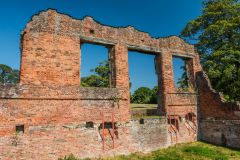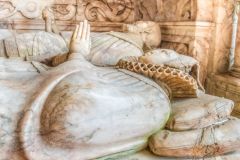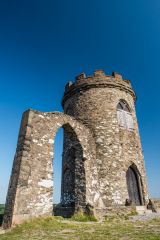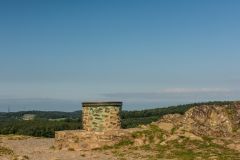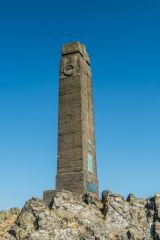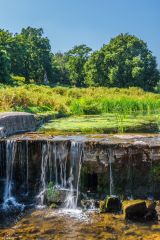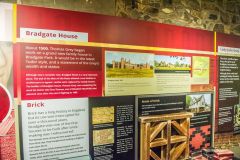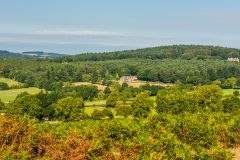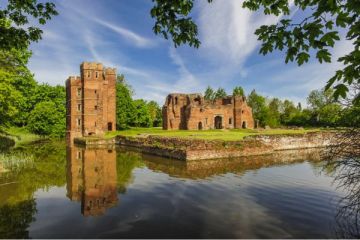
Bradgate Park is a large country park just north of Leicester. It is rare that a country park is also a site of outstanding historical significance, but that is the case for Bradgate Park.
The 830-acre park began as a medieval hunting ground and deer park and incorporates the ruins of a magnificent Tudor manor house, an iconic 18th-century folly, a 19th-century racecourse, a Victorian designed landscape, and a war memorial to the Leicestershire Yeomanry.
History
The history of Bradgate Park really begins in the 10th century, when records show that the estate here was owned by a Saxon nobleman named Ulf. After the Norman Conquest in 1066 much of Leicestershire, including Bradgate, was given to Hugh de Grentesmil, a Norman noble who fought with William the Conqueror at the Battle of Hastings.
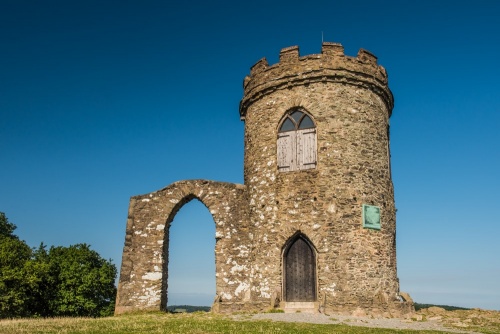
Deer Park
Sometime between 1066 and 1241 Bradgate was enclosed as a deer park, a hunting ground for Hugh or his descendants. We do not know when the first deer park was established but the Bradgate area was enclosed before 1241.
The Normans imported large herds of fallow deer from their lands elsewhere in Europe to stock their newly enclosed hunting grounds, sharing space with native roe deer. The herds of fallow deer you see at Bradgate today are the direct descendants of the fallow deer imported by the Normans to stock the deer park.
The deer park boundaries were defined by an earthwork ditch and bank topped by a timber palisade. The deer park boundaries were slightly different from the present park boundaries.

Deer Herd
Herds of roe and fallow deer roam the park as they have done for over 800 years. Fallow deer are suited to the open parkland areas, unlike native British roe deer, which prefer the wooded areas. There are roughly 550 deer, of which three quarters are fallow deer.
The deer are accustomed to visitors so you can get relatively close without alarming them. The visitor centre organises guided walks to explore the deer habitat. You can see the young stags in combat during rutting season in October. Large areas of the Park are kept free of public access to allow the deer space to roam freely.
Little Matlock
The park offers a wide variety of natural and designed landscapes, from rocky outcrops to picturesque landscaped areas. The Lower Park is relatively flat and easily accessible. The River Lin - the shortest river in Leicestershire - runs through this area on its way to Cropston Reservoir. Along the river is a cascade created during the Victorian period to clear silt from the river water before it emptied into the reservoir.
The area beside the river is known as Little Matlock since it closely resembles the Peak District landscape around Matlock in Derbyshire. Little Matlock was laid out in the 19th century as a planned landscape, incorporating exotic plants such as the monkey puzzle tree.
By contrast to the Lower Park and its gentle, relatively flat landscape, the Higher Park is an area of rocks and ancient trees, many of them 500 years old.
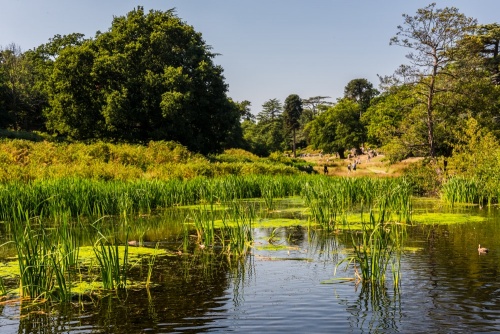
Old John Tower
At the highest point of the park is a picturesque 18th-century folly known as Old John Tower. The castellated Gothic tower was built in 1786 as an eye-catcher, a romantic landscape feature. an old (and entirely fictional) legend says that it was built to commemorate a miller who was killed when his windmill caught fire during celebrations to mark the 21st birthday of the 5th Earl of Stamford's heir.
The tower is such a popular landmark that it has been dubbed the 'Icon of Leicestershire' and its outline has been granted trademark status for the charitable trust that manages Bradgate Park.
Yeomanry Memorial
A short distance from Old John Tower is the Leicestershire Yeomanry War Memorial, occupying another rocky outcrop. The memorial was erected in 1924 to commemorate members of the Leicestershire Yeomanry regiment who fell in the Boer War and WWI. It was later updated to include the fallen of WWII. The memorial is in the form of a slender squared column with brass plaques set into one face near the base.
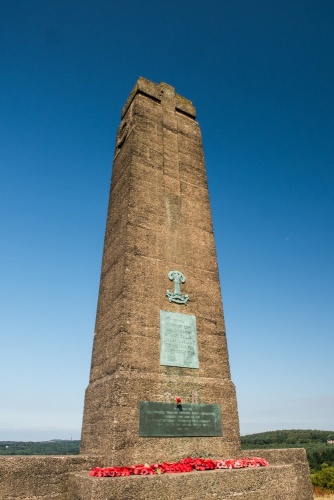
Bradgate House
Old John Tower looks down on the ruins of Bradgate House in the Lower Park. Bradgate House was begun in the 1490s and completed in 1520 by Thomas Grey, Marquess of Dorset. It was one of the very first houses in England to be built with brick, which was then an expensive and high-status building material. It was also one of the first large houses to be built without fortifications, a sign of the relative peace of the early Tudor period.
In 1537 Lady Jane Grey was born at Bradgate House. The future 'Nine Days Queen' spent her childhood at Bradgate and the tower where she likely had her private apartments still stands, though it is now roofless. The once-impressive manor house fell out of use in the 18th century when the Grey family moved to another of their houses.
You can explore the restored chapel, where you can see the ornate alabaster tomb of Henry Grey and his wife Anne, erected in 1614. Tours of Bradgate House can be booked through the nearby visitor centre.
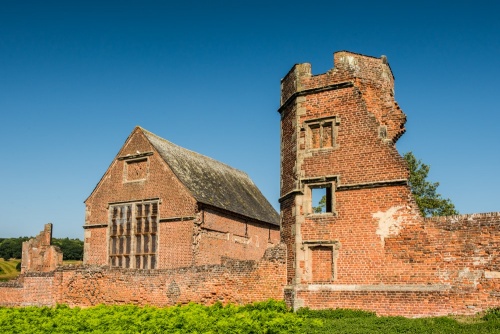
Visitor Centre
The modern visitor centre is home to a shop and museum where you can learn about the long history of the park, the deer herds, Bradgate House, and the multitude of landscape features that make the park so fascinating to explore. There is also a popular tearoom.
The park has never been cultivated, which means that archaeological evidence for early settlers remains intact beneath the surface for archaeologists to explore. The park is a designated Site of Special Scientific Interest (SSSI), a testament to its unique natural history and geology.
Getting There
Bradgate Park is located just north of Anstey. There are three main car parks, plus another two for the neighbouring woodland of Swithland wood, administered by the same charitable trust. The main visitor car park is off the minor road leading through Newtown Linford. Here there is a tearoom, shop, conservatory and information point. This is the best car park for reaching Little Matlock and the ruins of Bradgate House.
There is a second car park at the north-west corner of the Park. This is the Hunts Hill car park and is the best for reaching Old John Tower. The third car park is at the north-east corner of the Park and is the best for reaching Cropston Reservoir.
About Bradgate Park
Address: Anstey,
Leicestershire,
England, LE6 0HJ
Attraction Type: Countryside
Location: North of Anstey village. The main parking area is off the minor road through Newtown Linford.
Website: Bradgate Park
Location
map
OS: SK528105
Photo Credit: David Ross and Britain Express
HERITAGE
 We've 'tagged' this attraction information to help you find related historic attractions and learn more about major time periods mentioned.
We've 'tagged' this attraction information to help you find related historic attractions and learn more about major time periods mentioned.
Find other attractions tagged with:
NEARBY HISTORIC ATTRACTIONS
Heritage Rated from 1- 5 (low to exceptional) on historic interest
Old John Tower - 0.4 miles (Historic Building) ![]()
Bradgate House - 0.4 miles (Historic Building) ![]()
Stoneywell - 2 miles (Historic Building) ![]()
Kirby Muxloe Castle - 3.8 miles (Castle) ![]()
Leicester Abbey - 4.5 miles (Abbey) ![]()
Leicester, All Saints Church - 4.9 miles (Historic Church) ![]()
Leicester, St Margaret's Church - 4.9 miles (Historic Church) ![]()
Leicester, St Nicholas Church - 5.1 miles (Historic Church) ![]()
Nearest Holiday Cottages to Bradgate Park:
Ashby-de-la-Zouch, Leicestershire
Sleeps: 3
Stay from: £585 - 1927
Ashby-de-la-Zouch, Leicestershire
Sleeps: 8
Stay from: £590 - 2414
More self catering near Bradgate Park
